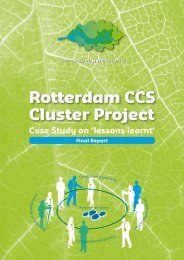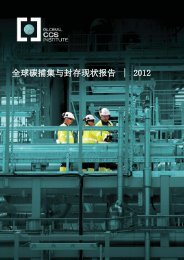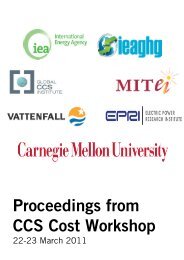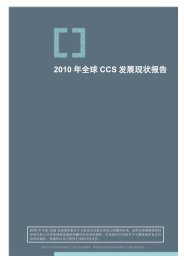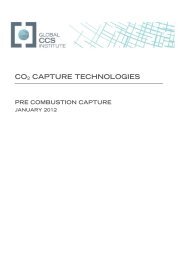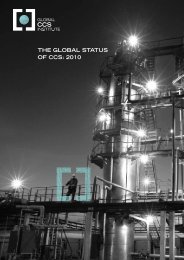Perceptions of CO2 Report - Global CCS Institute
Perceptions of CO2 Report - Global CCS Institute
Perceptions of CO2 Report - Global CCS Institute
- No tags were found...
You also want an ePaper? Increase the reach of your titles
YUMPU automatically turns print PDFs into web optimized ePapers that Google loves.
7.1.2 KNOWLEDGE AND PERCEPTIONS OF <strong>CCS</strong>Awareness <strong>of</strong> <strong>CCS</strong> varied across the three countries. Very few interviewees from Japan orAustralia had heard <strong>of</strong> it. Those interviewed in the Netherlands had greater awareness, with somereferring to the Barendrecht project 9 . The term “carbon capture and storage” was similarlyunfamiliar to members <strong>of</strong> the focus groups in Japan and Netherlands, but somewhat more familiarto Australian focus group members. Those who had never heard <strong>of</strong> <strong>CCS</strong> had varying mentalimages <strong>of</strong> the process; they imagined that CO 2 is stored in containers, or compared <strong>CCS</strong> tonuclear waste storage.<strong>Perceptions</strong> <strong>of</strong> <strong>CCS</strong>, measured after basic information on the technology (but not on CO 2 at thispoint in the survey) were presented, varied by country. Many respondents in Japan had afavourable attitude towards <strong>CCS</strong>, whereas the vast majority in Australia were negative towards it,and perceptions in the Netherlands were mixed. Respondents believed that CO 2 leakage wasinevitable and a high risk and that <strong>CCS</strong> is only a short term solution to reducing CO 2 emissions.Some also believed that <strong>CCS</strong> is limited by available storage capacity. Respondents with morefavourable perceptions recognised <strong>CCS</strong> as a feasible mitigation strategy and a developedtechnology.Respondents across all three countries tended not to support the planning <strong>of</strong> a <strong>CCS</strong> project neartheir homes. However, impressions <strong>of</strong> onshore and <strong>of</strong>fshore storage varied. Respondents inAustralia tended to see <strong>of</strong>fshore storage negatively owing to potential or perceived impacts on theocean. By contrast, Japanese survey respondents had more favourable impressions <strong>of</strong> <strong>of</strong>fshorestorage owing to its perceived minor effect on humans. Across the interviews and focus groups,respondents in the Netherlands slightly favoured <strong>of</strong>fshore rather than onshore storage.7.1.3 EFFECTS OF PROVIDING INFORMATIONInformation on where CO 2 naturally occurs and how it is used in commercial commoditiespromoted greater understanding <strong>of</strong> CO 2 among respondents, but did not drastically change theiropinion or perception <strong>of</strong> CO 2 and <strong>CCS</strong>. Respondents were surprised to learn how widely CO₂existed around them, both naturally and in commercial uses. They were particularly interested inthe natural phenomena <strong>of</strong> Lake Nyos, Mt Mammoth, and the Jackson, McElmo, and St. John’sDomes 10 . The former two examples caused concerns and reinforced perceived risks and dangers<strong>of</strong> <strong>CCS</strong>. There were mixed reactions to the example <strong>of</strong> the Jackson, McElmo and St John’sDomes. Some saw these as demonstrating that CO 2 could remain trapped for a long period <strong>of</strong>time, whereas others commented that <strong>CCS</strong>, because it is carried out by people, is different to thenatural underground occurrence <strong>of</strong> CO 2 .Information regarding CO 2 ’s properties was particularly influential in changing people’s perceptions<strong>of</strong> CO 2 and <strong>CCS</strong>. <strong>Perceptions</strong> became more positive as previous misperceptions regardingexplosiveness, flammability, and toxicity were dispelled. However, some respondents wereconfused by the fact that CO 2 was described as non-toxic, yet hazardous at certain concentrations.Also, respondents were interested to learn about the behaviour <strong>of</strong> CO 2 at different stages <strong>of</strong> <strong>CCS</strong>,and considered this information to be important. Descriptions <strong>of</strong> what could occur after CO 2 is9 Barendrecht was the first proposed onshore <strong>CCS</strong> project in the Netherlands, which was cancelled in February 2011 due to lack <strong>of</strong>public support.10 In the USA, CO 2 fields called the Jackson, McElmo, and St. John’s Domes were formed millions <strong>of</strong> years ago, and together hold 2.4billion tons <strong>of</strong> CO 2. This exemplifies how CO 2 has been securely sealed underground in natural underground CO 2 reservoirs for millions<strong>of</strong> years.18 | Understanding how individuals perceive carbon dioxide




